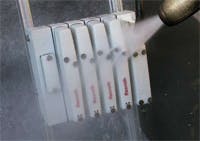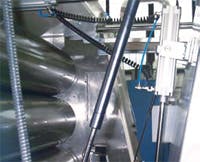Many industrial systems would malfunction if too much water were to spill on them. However, companies that continually process food must frequently wash down their machines to ensure the proper sanitary conditions are present. In these situations, pneumatics can be a smart option to decrease downtime, lower maintenance costs, and, ultimately, increase production.
Evergreen Packaging, a beverage and juice equipment manufacturer based in Cedar Rapids, Iowa, has used pneumatics technology for more than 30 years. Most of the equipment produced at Evergreen is gable-top equipment. The machines form, fill, and seal gable-top cartons in the dairy and juice industries. Pneumatics is an ideal solution for this type of environment. Because the equipment in a dairy or juice plant needs to be very clean to avoid contamination, it has to be washed down repeatedly. The machines are not only subjected to water, but are also exposed to chemical cleaners, such as sodium potassium hydroxide.
Advantages of pneumatics Wi th minimal contaminat ion risks, pneumatics is a clean technology and the first choice for food and packaging companies such as Evergreen. This circumstance makes it desirable for sanitary food applications compared to other technologies, such as lubricated mechanical components or hydraulics. According to Tim Hughes, development project manager for Evergreen, choosing the wrong technology can have negative effects on production: “In a wet environment, having leaked oil on a polished tile floor becomes a real safety hazard.” Using pneumatics, particularly for washdown and sanitary food applications, is an advantage because of the low maintenance costs and downtime associated with it.
“In the dairy and juice industry, you can’t afford to have downtime on a production line,” said Hughes. “Even if a machine stops working, milk is continuously coming in, and customers expect milk to be at the grocery store. Since stores get their milk shipments in everyday, avoiding downtime is absolutely critical.”
Hughes continues, “Regarding maintenance costs, dairies survive on very low margins. If they have high maintenance costs for keeping a piece of equipment going, that comes out of the profit from the facility. So, maintenance cost is critical. That’s the beauty of pneumatics; it’s easy to troubleshoot and to detect the problem without downtime being an issue.”
There are several other advantages to using pneumatics in food applications including its affordability and durability.
“A pneumatics system can be anywhere between 35-50% cheaper than a fully mechanical system,” Hughes said. “Most importantly, it is so user friendly. The sheer muscle of pneumatics — an air cylinder is basically a mechanical muscle — allows you to do so much with it and makes it so easy to use and control. It has become very reliable.”
Selecting pneumatic equipment
Because it is cost effective and easy to maintain, pneumatics is ideal for food processing applications where washdown is a consideration. When using pneumatics in food applications, it is important to:
• Select the right product for each application — various products suit different needs.
• Mount the valves close to the cylinders to keep cylinder motion synchronized with the valves.
• Mount the cylinders so they can be easily cleaned.
• Decentralize valve manifolds on larger production lines.
• Dimension pneumatic systems for optimal performance.
• Ensure the air pressure is constant to maintain optimal actuator cushioning by placing the regulators close to the actuators.
• Filter the compressed air according to the applications for which it is being used. If possible, place filters by each valve manifold.
• Use food grade lubrication. Lubrication is generally not needed but, if it is used, it must be food grade (type NSF H1), and
• Involve your technology supplier from the beginning of the project to get the correct solutions for each application.
Industry gives a rating, such as IP65, to pneumatics components based on particle tight design and watertight design — the first number is the dry particle rating and the second number is the wet test rating. Bosch’s IP69K-rated pneumatic valves, such as the Clean Line Valve (CL03), withstand pressurized water and steam damage. To meet the IP69K rating, valves withstand pressure of 1450 psi at a distance of 4-6 in., with water (at a temperature of 80° C) flowing at 14- 16 in./min while the object is rotated between 0°, 30°, 60° and 90° angles. (For comparison, IP65 enclosures cannot allow dust to enter and a jet nozzle splashes a volume flow of 12.5 lpm from a distance of 2.5-3 m.)
Pneumatic actuators are also used in sensitive washdown applications and with parts that are in direct contact with food. If applied incorrectly, pneumatic actuators can act as bacterial pumps, so it is important to ensure they are fitted properly. For harsh washdown applications, cylinders may contain rounded corners for easy drainage, positive sealing, “male” cushion-screw, clean cylinder-noses, and food grade lubrication.
According to Hughes, “Ours is a washdown environment. We have to assume everything we use is going to get a bath every day. A lot of valve companies in the industry claim to have IP65 products, which means the valve can handle hose-directed water. Our experience has been that the IP65 components really don’t work as well as some manufacturers claim they do. With the Clean Line products from Bosch Rexroth, the design is specifically IP69K, which is extremely watertight. All the surfaces are either plastic or stainless steel, so you don’t get any corrosion from cleaning chemicals, versus other valves that use aluminum or some lesser metals that would corrode.”
For washdown and sanitary food applications, pneumatics applications provide effective prevention against contamination while maximizing operational costs, guaranteeing food quality and improving production capacity. No matter what equipment is chosen, the key points to remember are it must be easy to clean and maintain.
While a box of chocolates left out at work may disappear extremely fast, the production of fine chocolates and confectionery is timeconsuming, not to mention expensive.
Nevertheless, the demand for sweet delicacies has been growing for years. Carle/Montanari SpA, Rozanno, Italy, has developed a refining machine that makes it possible for the confectionery trade to save on costs and continue to improve the quality of its chocolates.
The HFE-518 refining machine for processing and refining bulk chocolate makes on-going quality monitoring possible. Any deviations in relation to quality are automatically corrected during the manufacturing process by changing certain settings. Once the raw mixture has gone through the HFE-518, it turns into an interim product — the finest powdered chocolate.
Quality is king
The raw mixture comes into the refining machine via a hopper and is refined as a result of the crushing action of five parallel rollers, which are arranged vertically, one above the other. Each roller is located at a certain distance from the next one, to accommodate a defined quantity of the raw mixture. As the rollers rotate, they gain speed, the speed increasing from the first through to the fifth upper roller, which may achieve a speed of 400 rpm. The rotational movement transports the product between the five rollers as if it were a film. As it passes through the rollers the mass is dried and ground to a fineness of 15-30 μm.
The HFE-518 is capable of processing 1000- 1200 kg of bulk chocolate per hour. Pressure, speed and temperatures can be controlled and programmed by means of an electronic control via a remote monitoring PC.
The refining machine can be fitted with a patented independent (closed loop) control system and these control devices ensure that it is always in a position to produce a consistent finished product. Should the characteristics of the raw mixture deviate from the specifications during processing, the control system will automatically adjust the refining machine settings until the quality parameters specified have been re-established. This means that a high standard of quality is always guaranteed.
High-performance pneumatics
The machine is fully equipped with pneumatic components from Bosch Rexroth Corp. Special emphasis is placed on the pressure regulating system in the pneumatics circuit, which is fitted with Series ED05 electropneumatic pressure regulating valves. These are known for their high dynamic performance, reliability based on field testing, and high throughput capacity of 800 lpm.
High performance is not the only concern in food procession — compact sizes are also in demand, due to the often confined spaces in designs. “The reason we have opted for the Series HF03 valve units is to enable us to meet requirements in relation to quality and construction,” explains Piero Facchini from Carle & Montanari’s technical department.
The valves in this series feature compact size, low maintenance, plugin construction, and low energy consumption. In addition, the company has been able to considerably reduce the number of valves needed in the machine by comparison to earlier series.
“The Rexroth engineers were there right from the start. They did not just supply the components, they also provided us with support in other technical respects”, says Facchini.




